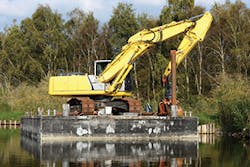Throughout the 1800s, skies over European cities were dark with the smoke of burning coal. In Britain alone, dense populations, a shortage of wood, and new commerce derived from steam power “fueled” coal’s use from 50 million tons in 1850 to 250 million tons by 1900. For rich and poor, the sulfurous, large black chunks of soft coal were a staple commodity and primary source of heat, energy, and industry.
Along the way, methods improved for carbonizing coal—heating it at high temperatures in furnaces—to make coke. This refinement became the key to meeting increased demands for iron and steel production, and it provided a source of fuel for locomotives. With coal-gas-powered lighting and longer workdays, the Industrial Revolution flourished, and with the dubious benefits of longer workdays, life sped on toward a new century. Galvanized by coal, business was booming, new technologies arose, and metered gaslights lit parlors, brought theatres to life after dark, and brought safety to street corners.
Amidst these innovations, a byproduct called coal tar was created. This sticky, viscous stuff (resembling the creosote made from wood used on railway ties) turned out to be ideal for mixing with stones to create a sealed, waterproof surface called tarmac (tar over macadam). Scientists found that coal tar had medicinal properties, too, and discovered a chemical cornucopia of agents that could be derived from the product.
A Miracle in the Making
But one product, first synthesized by German scientists, came to be hailed as a miracle discovery. It was nonflammable, had tremendous insulating capacity, and could be used as a coating, an extender for paints, a flame retardant, and much more. It was inert, nonreactive, and nonconductive with a high flashpoint. This miracle product derived from coal tar was called polychlorinated biphenyl (PCB), and for decades its stable chemical properties were exploited for everything from carbonless paper to waterproofing. One of its biggest draws came during the electrification boom. Its stability and inert property made it perfect to insulate transformers and capacitors.
PCB sold in huge quantities around the world. Scientists continued to experiment and found the properties of the substance could be enhanced. With added carbon atoms and chlorine mass, PCB became a nearly waxy substance, ideal as an extender for pesticides to increase their adhesion when sprayed. And it lasts—resistant to processes of natural degradation—for a long time, cycling through air, water, and soil for decades.
Today, however, with the benefit of history, biomedical science, and technology on our side, all of this sounds like a recipe for environmental disaster. Which in effect it was. PCBs were the proverbial double-edged sword. They could reduce the risk of death from fire when added as a flame retardant to clothing and upholstery, keep capacitors and transformers cool, and stabilize paints, hydraulic fluids, and floor finishes. Yet it was these very desirable attributes that made them the lingering environmental health threat that today, more than four decades after they were banned from use, continue to plague us in with their resistance. And the US was the largest producer of PCBs.
“We didn’t always hate them,” says Kevin Sowers, Ph.D., associate director and professor at the Institute of Marine and Environmental Technology (IMET) at the University of Maryland in Baltimore. “They were called the ‘miracle chemical’ because of their stability and were perfect for cooling. PCBs used for cooling in high-temperature situations would not boil off, and because they had dielectric properties they could insulate but not conduct. They were safe to use and would not short out electrical elements, such as transformers and capacitors.
“But because they are this miracle,” he explains, “they aren’t going anywhere, and the manufactured product was so stable in its enhanced forms they are not going to break down from exposure to natural environmental processes. They need to have special enzymes to break down, but you need a way to get the enzymes to these chemicals.”
As an anaerobic microbiologist, Sowers has been involved in researching methods that would be the perfect “organic recipe” to render PCBs harmless, because as he explains, “this is a global problem and they are found everywhere, including such unlikely places as the Arctic.”
WHAT EXACTLY IS
A PCB?
PCBs can come in hundreds of varieties, called congeners, but the basic structure, explains Kevin Sowers, consists of two six-carbon rings—also called benzene rings—that are joined together.
Two carbon rings bonded together by one carbon on each ring create a biphenyl. When you add one chlorine, you have a monochlorobiphenyl; two chlorine create a dichlorobiphenyl; three chlorine create a trichlorobiphenyl, and so on. Collectively, they are know as polychlorinated biphenyls.”
Sowers explains that adding chlorines to this organic compound makes it very stable, but the number and location of chlorine atoms on the molecule determines the toxic properties. He says there are 209 combinations, or congeners; the most toxic have dioxin-like properties (such as Agent Orange) and are known carcinogens. Others are endocrine disrupters that can disrupt the reproduction cycle of animals and possibly humans. Still others are potential neurotoxins and cancer-causing agents.
Early Warning Wake-Up Calls Largely Ignored
For decades, scientists and health professionals knew that the chemical exerted dangerous properties. More than 100 years ago, exposure to chlorine during manufacturing caused disfiguring acne on workers, and the condition was dubbed chloracne, yet it would be another half century until the link to aromatic hydrocarbons was identified.
As the beneficial uses of PCBs multiplied, manufacturing escalated, and users and manufacturers of PCBs often put the effluent from those processes into the sewer systems, most of which were directly linked to public waterways. By the 1930s, public health experts were finding links between liver damage in plant workers and exposure to chlorinated hydrocarbons. For the next several decades, wrangling among health advocates, government, and corporate decision makers over the use of PCBs dragged on. Medical experts, scientists, and corporations had more than enough evidence that these agents were harmful, but workers, waterways, and food sources continued to be exposed. Finally, in 1979, EPA banned PCBs, but much damage had already been done.
However, it was the public outcry over PCB contamination arising from the grassroots efforts of residents along New York’s Hudson River that became the catalyst for real action. According to the New York Riverkeeper, a not-for-profit organization that advocates for water-quality issues, “Between 1947 and 1977 two General Electric (GE) capacitor manufacturing plants discharged an estimated 1.3 million pounds of PCBs into the Hudson River.” These contaminants are now “found in sediment, water and wildlife throughout the Hudson River ecosystem as far south as the New York Harbor” and “also found in people,” says Riverkeeper.
No Escaping the Legacy
“When these chemicals become part of the sediment of waterways, they enter the food chain, first through small organisms deep in the soil, then worms who consume them, then fish, and then humans,” explains Sowers. “As citizens saw the effect of contaminants with numerous deformities in fish, EPA took GE to task, ordering them to clean up the river. The plant was shut down, but the problem was that there were already so many [PCBs] they had seeped down into the shale and contaminated wells; the company had to pump the PCBs out from under the limestone.”
The cleanup involved the then-current practices of remediation—which Sowers says have changed little in the 21st century. They were tedious, invasive to the environment, cumbersome, and very expensive, involving dredging, hauling away of the sediment to a landfill, capping with clean sand, and sometimes incineration. The Hudson River remediation was a huge undertaking, costing billions of dollars, that is just now in the final phases of completion.
Even on a small scale, “these practices quickly run into millions” with complex strings of liability that can be nearly impossible to sever, explains Charles Edwards, town council member of Alta Vista, VA, a small town situated outside of Lynchburg. Alta Vista has a population of just under 4,000, and coming up with an extra $10 million to $11 million for remediation of the town’s pond contaminated with legacy PCBs is a daunting challenge at best. “Years ago, PCBs were widely used in industry, and one of the plants in this area apparently just flushed it into the sewer system, which ended up in our pond,” says Edwards. “It is a clay lined treatment lagoon for overflow, and there is no ingress or egress.” So what gets in stays in.
After much discussion, the town was considering dredging and hauling the sediment to a landfill, or incinerating it. “But what happens if you dredge,” says Edwards, “and let’s say the truck overturns on the highway, and the PCBs spill all over the road, the original owner—and that’s us—is still liable for it.” And once the sediment is transported to a landfill, should the landfill become insolvent and the owners skip town—”which is known to happen,” says Edwards—the original owner is still liable for whatever was dumped there.
There’s no escaping responsibility, and because some of the PCBs can take several decades to break down, it is a burdensome legacy.
Beyond these problems, the interventions disturb the environment, not only affecting the habitat of wildlife and plant life but also allowing some of the PCB-laden sediments to escape and make their way into other regions.
Turning the Corner for a Permanent Solution
The unsatisfactory outcomes of current remediation have been a factor in Sowers’ investigations. For the last two decades, he has been spearheading scientific research into the microbes of sediments contaminated with PCBs, with the idea that eventually there would be a clue to breaking down these agents and eliminating them from the environment once and for all. “It was known that if you took the sediments and put them in a bottle without oxygen, the PCBs would lose most of their chlorines, but nobody knew why,” he says. Early on, GE spent a lot of money looking for microbes that would break down the harmful agents, but Sowers says that at the time, science did not offer today’s sophisticated technologies to analyze DNA.
By the late 1980s, instruments for polymerase chain reaction (PCR) assays were becoming available, which allowed researchers to clone DNA for investigations, a technique Sowers and collaborator Harold May, Ph.D., at Medical University of South Carolina used to begin unlocking the secret to PCB destruction. Sowers explains this was the stepping stone that started the path to achieving his latest results, reported in late 2015, which by all accounts will revolutionize PCB remediation—in terms of expense, time, and sustainability.
IMET: A Case for Basic Science Research
Russell Hill, Ph.D., director of IMET, says the name truly embodies what the organization does in its research labs headquartered in Baltimore and in collaboration with partners around the world. “We’re called the Institute of Marine and Environmental Technology, which means we do research, but our focus is on developing technologies that get this research where it is useful and practical.”
Sowers’ work, Hill says, is a prime example of what IMET does. “Kevin [Sowers] has been working for 20 years, putting in the first hard slug of understanding the basic biology of microbes breaking down the PCBs. It’s taken two decades to get to the point where it’s really paying off now in a big way.”
Hill adds that Sowers’ work is one of the exciting examples that has “reached the stage for prime time, and for commercialization,” and efforts that began in 1991 are “now ready to transfer that technology into the real world.”
IMET illustrates how public funds that support basic science can lead to solving important environmental problems affecting public health, safety, and our crucial natural resources. “We are supported by the University of Maryland state system, so we receive our funding from taxpayers, and our world-class faculty works hard to spend these dollars wisely and to also pursue private sources for additional grants,” says Hill.
“When we explained our research and how it is leveraged toward practical applications, other agencies such as the National Science Foundation, the National Institutes of Health, and the Department of Defense all stepped up to fund our efforts.” Better food safety, for example, can be achieved by making marine life safe to harvest as a food source when PCBs are eliminated from the water column.
To continue reading the full article check out the March/April edition of Stormwater, please click here. You may need to log-in or subscribe to our magazine.

